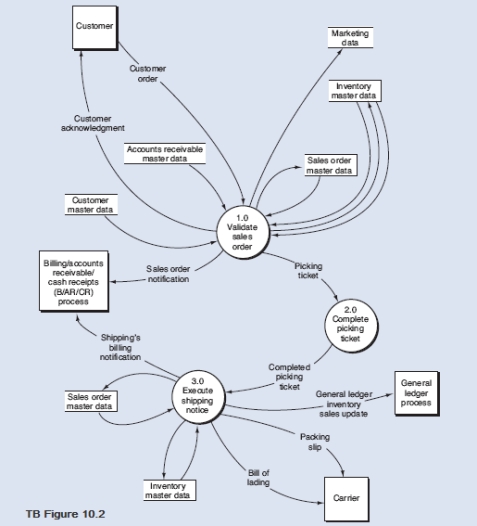Below is a narrative of the "Validate sales order" portion of the order entry/sales process.Narrative Description
How does the OE/S process then validate a customer order? First, process 1.1 verifies the availability of the requested inventory by consulting the inventory master data.If a sufficient level of inventory is on hand to satisfy the request, the order is forwarded for further processing, as depicted by the data flow "Inventory available order." Conversely, if a customer orders goods that are not in stock, process
1.1 runs a special back order routine.This routine determines the inventory requirement necessary to satisfy the order and then sends the back order request to the purchasing department.This activity is depicted by the "Back order" data flow, which in reality is a specific type of exception routine (i.e., a specific type of reject stub).After the goods are received, the order is routinely processed.If the customer refuses to accept a back order, then the sales event is terminated, and the order is rejected, as shown by the "Reject" data flow.Information from the order that has potential value to
marketing is recorded in the marketing data store.After assuring inventory availability, process 1.2 establishes the customer's existence and then evaluates credit.With an enterprise system, one record should exist for each customer, wherever the customer is located and from whatever parts of the organization the customer makes purchases.This allows an organization to readily determine the amount of credit available to that customer worldwide.The credit check adds the amount of the order to accounts receivable balances, open sales orders (i.e., orders about to be receivables), and compare that total to the credit limit.If the customer has exceeded their credit limit, the order is rejected.Upon a successful credit approval, process 1.3 performs the following activities simultaneously:
-Updates the inventory master data to allocate the quantity ordered to the sales
order.The inventory balance could actually be reduced at this time to save a later
update of the inventory master data.-Updates the sales order master data to indicate that a completed sales order has
been created.-Disseminates the sales order.Required: From the DFD in TB Figure 10.2 and the narrative description above, explode bubble 1.0 into a lower-level diagram showing the details of that process. 
Definitions:
Environmental Statutes
Laws and regulations aimed at protecting the environment from harmful activities and promoting sustainability.
Racketeering Activity
Illegal activities carried out as part of an organized crime operation, often involving extortion or fraud.
Legitimate Enterprise
A business or organization that is conducted lawfully and with genuine intentions.
Otherwise Legal
Pertaining to actions or conditions that are permitted or recognized by law, except for specific exclusions or conditions.
Q23: A fidelity bond indemnifies a company in
Q33: In a post-billing system, invoices are prepared
Q34: In a voucher system, the data flow
Q45: Which control plan for the cash receipts
Q51: Business continuity planning is the process that
Q52: The function composed of people, procedures, and
Q55: The shipping clerk compares each line on
Q71: Establishing a viable internal control system is
Q84: Below is a narrative of the "Validate
Q135: The functions of the _ commonly include